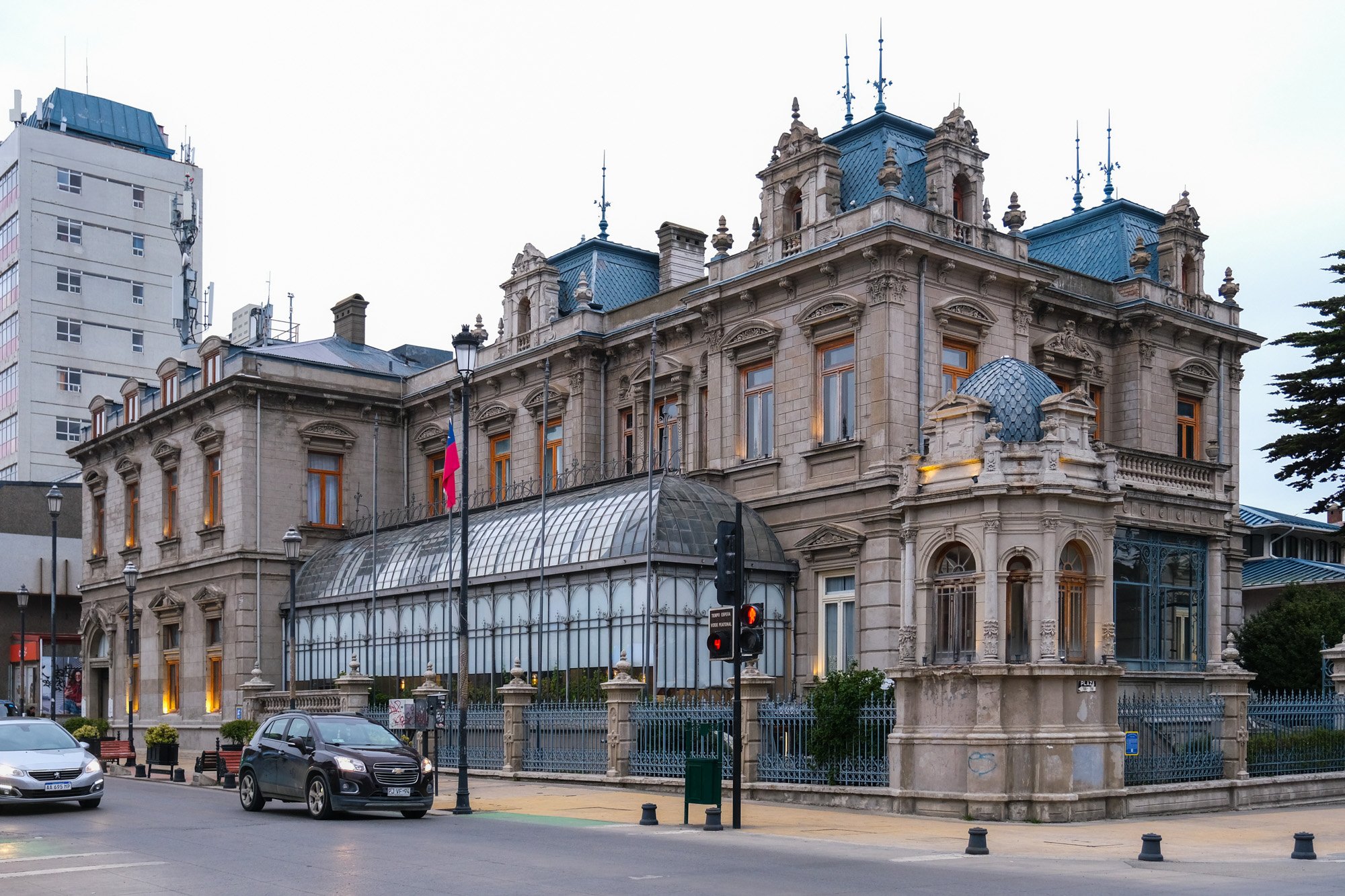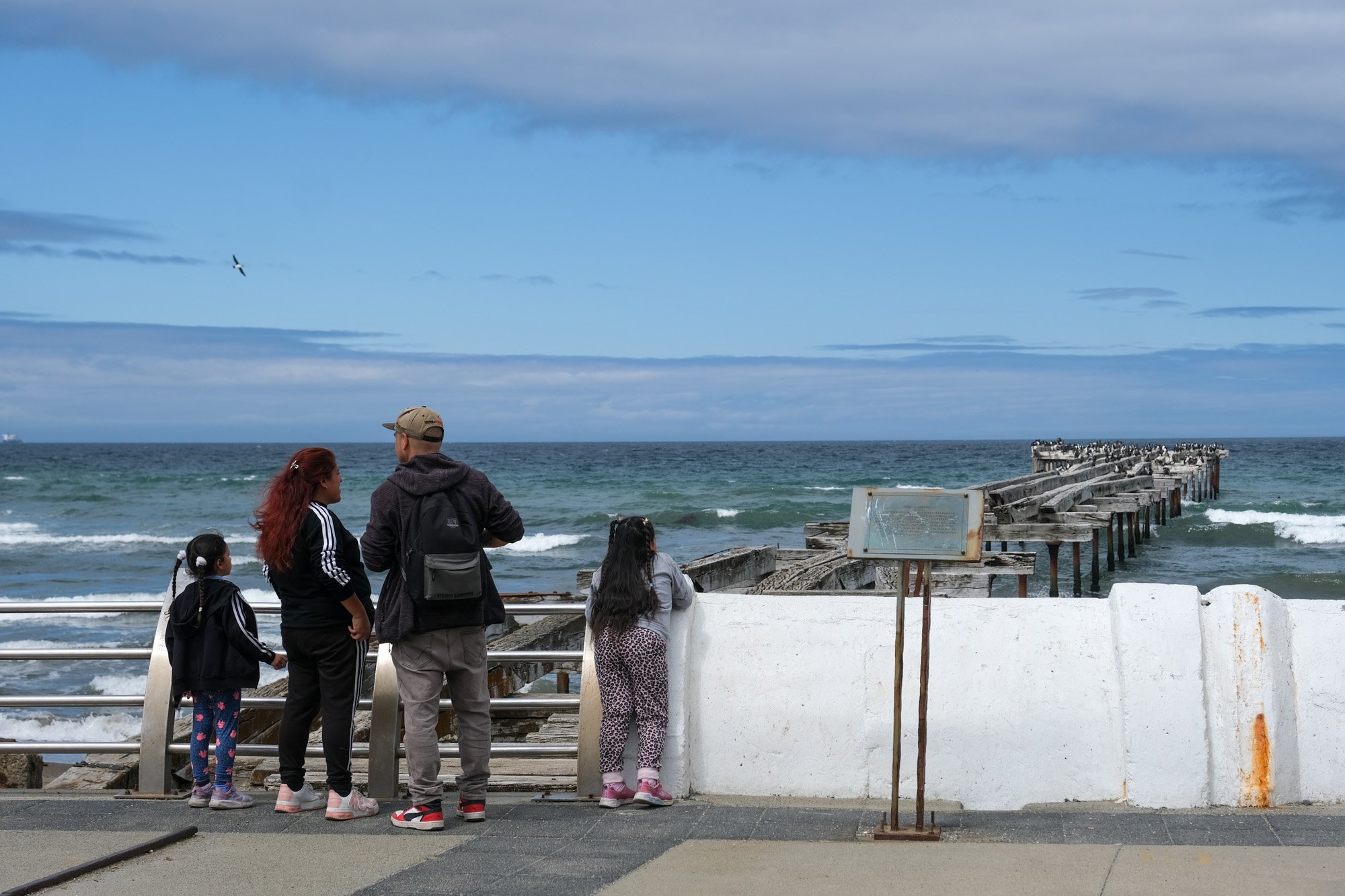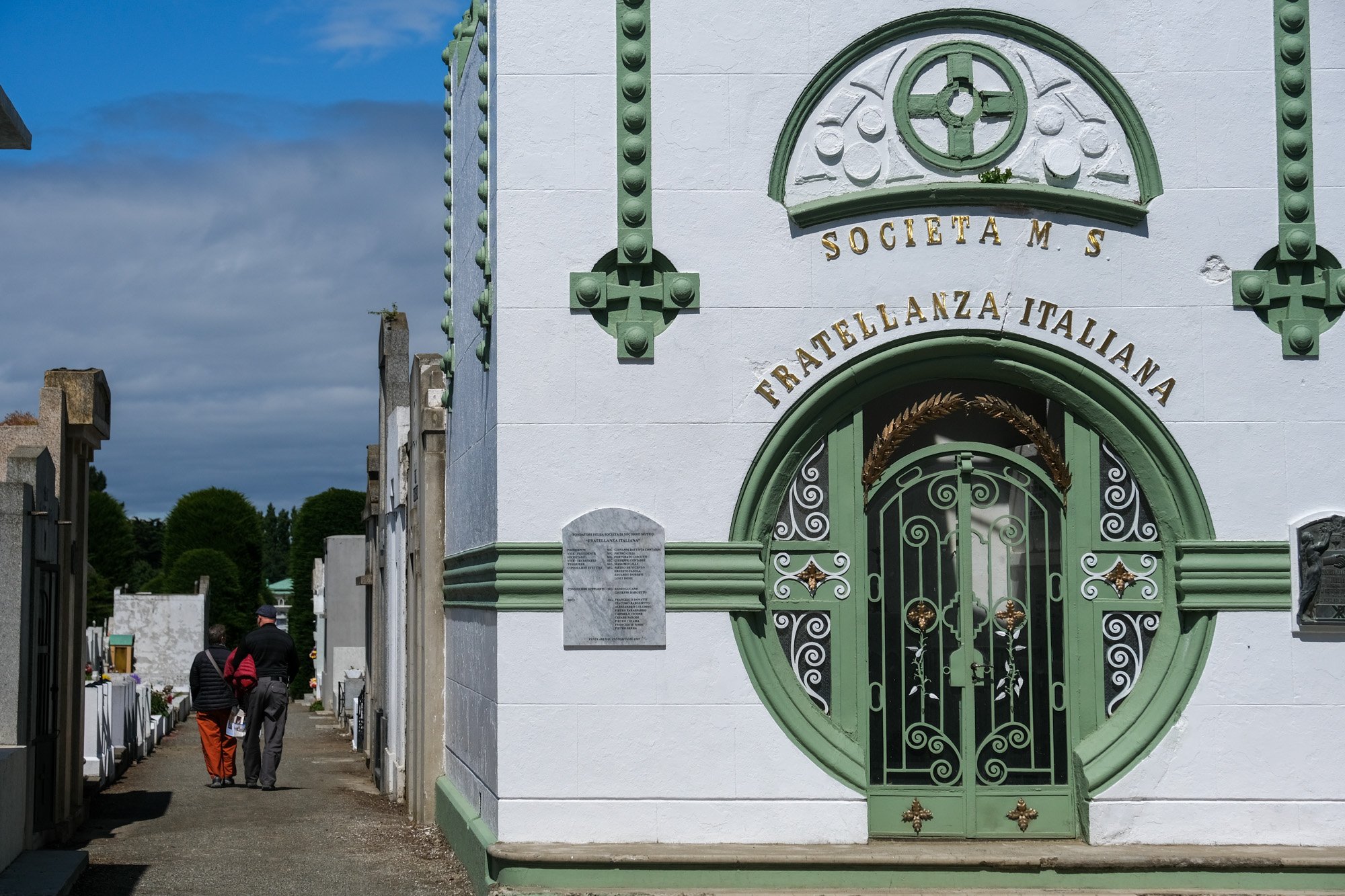The Southern Frontiers of Punta Arenas
After five days in the Atacama Desert, we were more than ready for a change of scenery. Sunburned and exhausted, I had never been so looking forward to overcast weather on vacation. As much as we enjoyed our time in Atacama, we could not wait for Patagonia's cool, misty air. Because there was no direct flight between Atacama and Patagonia, our red-eye flight had a four-hour layover in Santiago. A three-hour delay at Calama Airport meant a sleepless night for us. I was most nervous about potentially losing my rental car reservation, which was very precious during the tourist high season.
Thanks to the layover, we were able to catch our flight to Punta Arenas, the capital of Chilean Patagonia. The plan was to spend a day here before heading to Puerto Natales and Torres del Paine National Park. Punta Arenas may be a brief stop, but it is the place that intrigued me most due to its history and unique geographic location. It may not be well-known internationally, but it was once one of South America's most strategic and prosperous cities. Despite being only a shell of its former self, it is still the southernmost city (with a population of 100,00 or more).
We felt a sense of relief as soon as we exited the plane. Considering the dramatic change in landscape and climate, we could hardly comprehend that we were still in Chile! The pine trees and the ocean views looked particularly beautiful after days in the desert. The architecture and scenery here immediately reminded us of Iceland, and we really liked it. I can’t help wondering if the country's geographic spread is detrimental to Chile’s national unity. How often do Chileans relocate or visit the other end of their country?
Fort Bulnes
Even though we had a blast in Atacama, we secretly craved the creature comforts of a modern metropolis. That includes a cafe with a decent cup of cappuccino and fancy restaurants. After a satisfying breakfast at the bustling Wake Up - Coffee & Brunch, we headed south toward Fort Bulnes, the “birthplace” of Punta Arenas. Situated 45 miles south of the city center, the 150-year-old fortress may be one of the region's most important historical sites, but visitors often overlook it due to its location. Most seem to prefer the penguin-watching excursion to Isla Magdalena instead.
Thanks to its remoteness, the area surrounding Fort Bulnes retains much of its geographic authenticity. The historical core of the fort is located approximately five minutes away from the ticketing station. We arrived just in time for their English-guided tour. Since we were the only English-speaking visitors at the time, we had the tour guide all to ourselves. The fort was constructed on the order of the Chilean President Manuel Bulnes in 1843. The strategic location was intended to exert control over the Strait of Magellan, the vital passageway connecting the Atlantic and Pacific Oceans.
I must admit that I was not familiar with the history of the Strait of Magellan. I might have remembered the Portuguese explorer's name and heard of the strait in history class, but I did not register the significance of this spot. First navigated by Ferdinand Magellan, the Strait of Magellan is the most critical navigable sea route in South America, as it allows ships a relatively calm passage compared to the iceberg-filled Drake Passage. This was one of the most trafficked sea lanes in the Western Hemisphere until the opening of the Panama Canal in 1914.
Besides its military importance, the fort was also an important stake of claim by Chile of the southern frontiers against other foreign interests, including Argentina. Fort Bulnes was located at this spot as a military outpost for military purposes, not for the abundance of natural resources. The Spanish had attempted to settle here three hundred years prior, but the lack of arable land led to extreme starvation. Despite Chile’s concerted efforts to bring settlers to the area, the fort and settlement here only lasted six years before the government decided to relocate to a more suitable location, the present-day Punta Arenas. The fort was abandoned and burned to the ground.
It was not until the 1940s that the fort's remnants were rediscovered and rebuilt. The restored complex may not be the most impressive fort, but its rustic appearance was utterly charming, especially in stormy weather. Considering that the entire fort was burned to the ground, I was skeptical about how authentic the reconstruction could be. That said, it gave us a glimpse of how primitive and challenging life might have been at the fort. Needless to say, there is no insulation in these buildings, and the log construction is credibly drafty. The interiors were cold and damp even in the middle of summer.
The reconstruction included a chapel, a guard tower, and a makeshift prison entirely made of logs. It was cozy, to say the least. A few sections of the ramparts were also restored and outfitted with historic cannons. This setting and ambiance actually reminded me of Fort Ross on the California coast, albeit far more rustic. Over the past few years, the park developed a network of hiking trails around the fort to draw in more visitors. It was only a few minutes’ stroll before we reached the southeasternmost tip of the peninsula. From this viewpoint, we could see the majestic, snow-capped Patagonia. As we looked at the map, it dawned on us that this spot is only twenty miles from the southernmost point of the South American continent! The land mass south of here is Tierra del Fuego, merely an archipelago.
The park also features a modern visitors' center with state-of-the-art exhibition space, a variety of gift shops, and a cafeteria. The rotating exhibits on local photography and the marine ecology of Patagonia. However, my favorite exhibit was dedicated to the evolution of seafaring vessels that passed through the Strait of Magellan. Among the famous ships that sailed in these waters were Trinidad and Victoria. However, the most famous vessel that passed through here would probably be the HMS Beagle, which is made famous by Charles Darwin. People of Punta Arenas take their maritime heritage seriously. Visitors can visit the Museo Nao Victoria to see numerous full-size replicas of these historic vessels, including HMS Beagle.
Downtown Punta Arenas
After visiting Fort Bulnes, we could understand why the government chose Punta Arenas as a more suitable settlement. The flat topography by the shore makes transportation and agriculture more feasible. To attract more settlers, the national government offered land concessions in 1867 to Chileans and foreigners willing to settle in the area. It marked the beginning of a period of immigration from far and wide. The British immigrants formed the first wave of arrivals, followed by Croats and Germans over the next few decades. Other prominent groups include Italian, Irish, Swiss, and Spanish. As a result, Punta Arenas always retained its cosmopolitan character.
Not only does this diversity reflect in the names of the buildings. Among them, the Corat influence seemed particularly prominent. Today, approximately five percent of all Chileans identify as Croatian in terms of their ethnic heritage. All around town, we spotted Slavic names and Croatian national coats of arms on almost a dozen buildings. It never occurred to me that Chile, Brazil, and Argentina are all countries of immigrants. As Americans, we sometimes forget that the immigration stories to the “New World” are not unique to North Americans.
During the golden age of Punta Arenas, wealthy merchants built grand mansions and civic architecture to demonstrate their wealth and influence. The most famous among them is the Sara Braun Palace, situated right on the main square. Sara Braun emigrated from the Tsarist Latvia to South America at a young age, before settling in Punta Arenas at the age of twelve. Through her father, she met her husband, José Nogueira, a Portuguese shipping magnate with vast land leases and business holdings in the region. She eventually inherited the fortune when he passed away six years later.
Braun turned out to be a capable manager in her own right. Her business empire continued to prosper, controlling over 7,400,000 acres of land at one point. She established a near-monopoly in sheep farming. She became the wealthiest person in Southern Chile and perhaps even the richest woman in Chile. She devoted a considerable amount of wealth to a wide range of philanthropic endeavors, both locally and internationally. She was also extremely generous to those who worked for her, bequeathing shares of her company to acquaintances, employees, and various charities for the poor. To call her a pillar of the community would be an understatement.
Braun may be big on charitable endeavors, but she also knew how to enjoy life. A few years after her husband’s death, she commissioned French architect Numa Mayer to build her a lavish neoclassical mansion, which took ten years to complete. She spared no expense; the house includes an ornate Victorian conservatory and grand portico. The lavishness of the building stands in contrast to the harsh landscape of the Patagonia region. The house is now home to the Union Club of Punta Arenas, an upscale social club.
As a frontier settlement, the city is laid out in a grid with a central square, Muñoz Gamero Square. The grand plaza is the beating heart of the town. Nestled among the rows of cypress trees are numerous historic monuments. In the center of the plaza stands a grand monument dedicated to Ferdinand Magellan, commemorating the fourth centenary of the European discovery of the Strait. Besides the navigational equipment, the base of the monument is adorned by statues of the indigenous people. Popular legend has it that if you kiss the bare feet of one of the statues, you are destined to return to Punta Arenas in the future. Since this is a major port for Antarctic cruises, we certainly would not mind returning.
While the legend may seem lighthearted, it is worthwhile to explore the darker history of European colonization. Patagonia was home to the indigenous Selkʼnam people, among the last group to encounter Europeans. Despite living in a harsh environment, they were known for wearing few clothes and having elaborate body paint. The distinctive body paint colors and patterns used during their male initiation ceremony are particularly memorable and eye-catching. Visitors could find their imagery and statues outside tourist shops. They inadvertently became the most effective mascot for Patagonia.
Selkʼnam culture may be a tourist draw nowadays, but they were targeted by a well-coordinated extermination campaign at the turn of the 20th century. The Tierra del Fuego Gold Rush brought many Europeans to their native habitats. When the gold was depleted, they began to raise livestock on the land. Because the concept of private property was foreign in Selkʼnam culture, they began to “poach” the livestock. This eventually led to a coordinated genocide led by the government and private companies, including the company of Sara Braun. The Selkʼnam population was decimated, and their culture was nearly erased if not for the help of Christian missionaries. Although fewer than two thousand Chileans still identified as Selkʼnam, generations of forced assimilation meant that little of the indigenous traditions survived.
Speaking of tourist shops, we were both pleasantly surprised by the number of tourists milling around town. Objectively speaking, Punta Arenas may not be particularly photogenic or have many magnificent landmarks. I suspect many, if not most, came here with the cruise. While Argentina’s Ushuaia may be the most famous port of call for Antarctic cruises, Punta Arenas is the second most frequent stop on the itinerary. Chile is one of the original signatories of the 1959 Antarctic Treaty, which established a peaceful and consensus-based approach to governance. However, Chile has always been keen to assert its sovereignty over the Chilean Antarctic Territory. While we were there, President Gabriel Boric, a native of Punta Arenas, became the first head of state in the Americas to visit the South Pole.
With the cruise terminal a mere five-minute walk to the town center, Punta Arenas seemed like a better stop than most Caribbean ones. The city's ramshackle appearance and moody weather communicated a sense of great melancholy. It took me a few hours to begin appreciating the inner beauty of the place. Hidden behind the rustic facades are many amazing boutiques and restaurants. Of course, we couldn't visit without enjoying the bounty of local seafood, especially the southern king crabs (centolla). Although we enjoyed our upscale dinner at Restaurante La Yegua Loca, I much preferred the rustic lunch at the humble Roca Mar Comida Al Paso.
The culinary highlight for us was a visit to Kiosco Roca, a revered sandwich shop renowned for its Magellanic choripán— a combination of chorizo sausage, mayonnaise, and bread —and banana milk, the only items on the menu. This curious combination attracts admirers from far and wide. First opened in 1932, the establishment received the distinction in 2012 as the best budget-friendly eatery in Chile and now has branches in Valparaíso and Santiago. These humble sandwiches are insanely popular at just 900 CLP a piece; customers buy them by the dozens. Although they are not my favorite, their no-frill lunch counter is a great place to people-watch and chat with the locals.
Considering Punta Arenas’ modest size, we were surprised by the city's numerous historical monuments and memorials. It did not take us long to recognize that nearly all are related to the city’s maritime heritage. From the centennial of Magellan’s voyage to the celebration of the Chilean Navy, these memorials signify Punta Arenas’ frontier spirits. Among all the monuments along the shore, the most evocative would be the Goleta Ancud Monument. The towering memorial is dedicated to the 1843 voyage of Ancud, which was Chile’s first claim of sovereignty over the Strait of Magellan. It includes twenty-four crew members of the expedition, various livestock, and figures in Chilean folklore (Pincoya and Millalob). The scene is unabashedly nationalistic and heroic. It may not be to everyone’s taste, but I was immediately awestruck by the stylistic likeness to Swedish sculptor Carl Milles.
Even though Punta Arenas plunged into a precipitous decline after the opening of the Panama Canal, its economy gradually diversified to include fossil fuel exploration, fishing, and tourism in recent decades. Due to its strategic location, the city was designated one of Chile’s free trade zones. Climate change may also open up additional economic opportunities for the region. I can’t wait to return to witness the city’s continuous revitalization.
Cemetery of Punta Arenas Sara Braun
One unexpected tourist attraction in Punta Arenas is its municipal cemetery. The Cemetery of Punta Arenas is situated approximately ten minutes from downtown. It is often described as the second most beautiful cemetery in South America, second only to La Recoleta Cemetery in Buenos Aires. The ten-acre cemetery is the resting place for many early pioneers of Punta Arenas. Visitng cemeteries may not be for everyone, but I have always had a soft spot for them. Like Karl Pilkington said, it was fun to “walk around and see how old the dead people were”.
The cemetery is known internationally for its grand mausoleums, a tribute to the wealth of Punta Arenas’s merchant class. Most of these grand structures are located along the central axis and sport outlandish ornamentations associated with the family. Among them are the prominent Magallanes families represented here, including the Menéndez-Behetys, the Braun, the Blanchards, the Kusanovics, and the Menéndez-Montes. Without a doubt, the most famous mausoleum belonged to Sara Braun. The great business magnate and philanthropist was the primary benefactor of the cemetery. Legend had it that her patronage came with a condition that her coffin would be the last to enter through the main entrance. Her wish has been honored, as the main entrance has been permanently locked.
As magnificent as these mausoleums may be, the true beauty of the cemetery lies in the impressive cypress trees and burial plots for ordinary people. The cemetery is divided into distinct sections, each dedicated to specific ethnic groups: Italian, German, Croatian, and Russian. Of course, we had to check out the English section. However, judging from the burial data, I suspect that the ethnic divisions in Punta Arenas eventually faded. Or perhaps they just ran out of rooms. Naturally, the more recent burials were at the periphery of the cemetery. These graves certainly felt more intimate and personal.
The most intriguing tomb of all is the Grave of the “Unknown Indian” (Indio Desconocido). According to the legend, an unnamed Kawésqar man died on the island of Diego de Almagro during an armed conflict. The body was unusually well preserved after several days and was transferred to Punta Arenas for autopsy and then buried in an unmarked grave. As the only full-blooded indigenous person buried here, the grave soon earned the nickname “Unknown Indian” and was marked as such after ten years. For unknown reasons, the grave gradually gathered a cult following among the locals and people started making offerings of candles and small coins at the grave.
In 1960, a local woman began organizing to have the collected change donated to the local Red Cross. She eventually commissioned local sculptor Edmundo Casanova to create a statue of the unknown Indian. Countless ex-votos from the believers now decorate the massive epitaph. The faithful would pray by kissing his well-worn, shiny left hand. Acknowledging the draw in indigenous mysticism at the frontiers, the Catholic Church tacitly ignored the devotion to this unknown pagan. I suspect Sara Braun would be jealous of all the attention he is getting nowadays.






































